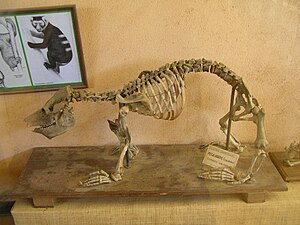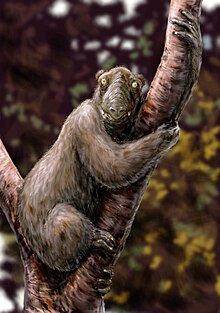Megaladapis
| Megaladapis | ||||||||||||
|---|---|---|---|---|---|---|---|---|---|---|---|---|

Megaladapis grandidieri in the Grandidier Fund |
||||||||||||
| Systematics | ||||||||||||
|
||||||||||||
| Scientific name of the family | ||||||||||||
| Megaladapidae | ||||||||||||
| Forsyth Major , 1894 | ||||||||||||
| Scientific name of the genus | ||||||||||||
| Megaladapis | ||||||||||||
| Forsyth Major, 1894 |
Megaladapis , sometimes referred to as "Koalalemuren" in German, is a genus of primates in Madagascar that became extinct around 1500. They are probably the best-known representatives of the giant lemurs , their closest living relatives are the weasel lemurs .
Description and assumed way of life

With a weight of 40 to 80 kilograms and a body length of up to 1.50 meters, Megaladapis was the largest Malagasy primate genus after Archaeoindris . Her skull showed some unusual features, the muzzle was greatly elongated and the face "tilted" upwards. Bone formations above the nostril indicate that the snout was very mobile. They did not have incisors in their upper jaws, but presumably instead had a horn plate like some ruminants. The molars had complex cusps and were unusually large.
The feet and hands were greatly elongated and enabled a firm grip on the branches. In contrast, the arms and legs were relatively short, but very strong and slightly curved, with the front legs being longer than the rear legs. Despite their weight, these giant lemurs were perfectly adapted to life on trees. Based on the physique, it is assumed that Megaladapis resembled the koala in locomotion and way of life . With all four legs they clutched tree trunks or large branches and moved slowly by climbing or by short hops. On the ground, however, they could probably only move slowly and heavily. Megaladapis probably ate leaves which she brought to her mouth with her hands.
The extinction
The bones found were 2,850 to 600 years old. Much has been speculated about the reasons for the extinction of these giant lemurs. It is probably connected with the colonization of Madagascar, the Malay immigrants cleared most of the forests and hunted the gigantic animals that previously lived without natural enemies. Climatic changes are also brought into play, during this time there was a dry period and thus a decline in forests, which decimated the populations so that they could no longer withstand the new pressure of immigrants. In general, large animals living on islands are particularly at risk from human hunting, as on the one hand they often reproduce very slowly and on the other hand they are coveted objects of hunting due to their lack of fear of humans and the large amount of meat. There has also been speculation about a deadly epidemic that people or the animals they brought with them to the island. Megaladapis should have died out around the year 1500, but there is a report about a gigantic primate species from the 17th century, which could apply to any representative of the giant lemur.
Systematics
There were three types:
- Megaladapis edwardsi was the largest species and is known from southern Madagascar. Possibly the species spent more time on the ground than the other members of its genus.
- Megaladapis grandidieri is occupied from the central and northern part of the island.
- From Megaladapis madagascariensis subfossil residues in south-western and northern Madagascar was found.
Megaladapis is classified in a family of their own, Megaladapidae, their closest relatives are the small, still living weasel lemurs ( Lepilemur ), which share some characteristics such as the lack of the upper incisors and are sometimes classified in the same family.
literature
- Thomas Geissmann : Comparative Primatology. Springer-Verlag, Berlin et al. 2002, ISBN 3-540-43645-6 .
- Ronald M. Nowak: Walker's Mammals of the World. 6th edition. Johns Hopkins University Press, Baltimore MD 1999, ISBN 0-8018-5789-9 .
- William L. Jungers : Osteological Form and Function: the Appendicular Skeleton of Megaladapis, a Subfossil Prosimian from Madagascar (Primates, Lemuroidea). Thesis (Ph. D.), University of Michigan, Ann Arbor 1976.

